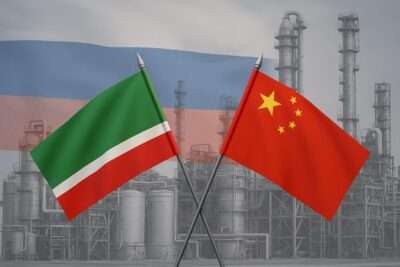
Executive Summary
This report assesses the strategic credibility, practical feasibility, and geopolitical implications of the planned Chinese investment trip to Chechnya in July 2025.
The delegation’s primary interest centred on assessing the viability of a large-scale nitrogen fertiliser plant proposed in Naursky District, executed by the Chinese engineering conglomerate Wuhuan.
Although Russian and Chechen leaders portray foreign investment as a sign of political and economic recovery, persistent structural problems, past project failures, and Chechnya’s relatively small economy represent obstacles for significant foreign investment.
Key Takeaways
The visit of Chinese investors in July 2025 shows Beijing’s companies are being cautious about their economic interests.
Although backed by Moscow’s financial support, Chechen investments still present structural challenges.
Any future Chinese investment in the republic can remain limited, highly conditional, and politically motivated.Background Information
During mid-July 2025, Grozny and its environs received a visit from a Chinese business delegation. This group comprised representatives from southern China’s industrial zones and a state-sponsored women’s entrepreneurship association. The agenda covered site visits, project presentations, and talks with local officials, especially concerning Wuhuan’s planned nitrogen fertiliser plant. Wuhuan is a major Chinese EPC contractor in chemicals and energy.
This 200 billion ruble proposal, with an estimated 2030 start date, will produce 1,700 tonnes of ammonia and 3,000 tonnes of urea each day. The project can create 600 jobs. Officials identified the site in Naursky District, spanning over 42 hectares. However, the project remains in the pre-feasibility phase because no contracts have been finalised.
Investment activity in the Republic of Chechnya declined significantly in 2025 compared to previous years. Except for a minor agricultural project and an accumulator factory, a history of Chinese investment announcements in the region has largely failed to result in functioning projects.
SWOT Analysis
Strengths
Federal Political Backing. Continued Kremlin support, both financially and politically, creates a favorable context for large-scale, state-sponsored projects in Chechnya.
Strategic Value for Russia. Because of its position in the North Caucasus and its symbolic loyalty to Moscow, Chechnya is a favoured location for federally backed investment displays.
SEZ Status and Incentives. The Special Economic Zone “Grozny” offers tax breaks and regulatory leniency for investors, reducing entry barriers for Chinese businesses.
Bilateral Engagement Platforms. The Kavkaz Investment Forum and ongoing diplomatic signals from Moscow and Beijing help maintain China’s prominent role in regional development talks.
Chinese EPC Capability. The Chinese company Wuhuan possesses the requisite technical experience and licensing to deliver fertiliser infrastructure within the Russian Federation, including in peripheral territories.Weaknesses
Unmaterialised Investment Record. Since 2011, the vast majority of proposed Chinese investments in Chechnya have not moved beyond the initial planning stages.
Market Size and Isolation. Compared to more central areas of Russia, Chechnya has a much smaller consumer market, logistics in need of development, and poor transport links between regions.
Institutional and Governance Risk. Chechnya’s governance makes contract enforcement and project oversight unpredictable.
Security Risk. Local crime and the persistent terrorist threat challenge foreign investors in the North Caucasian republic.
Financial Dependence. The regional economy shows an extensive dependence on subsidies, with limited capacity for autonomous project funding or public-private partnerships.Opportunities
Geopolitical Realignment. Western sanctions on Russia open a space for Chinese economic expansion into the local markets with limited global competition.
BRI Expansion Logic. As a potential minor transit route within the larger Belt and Road Initiative framework, Chechnya could provide a symbolic presence in the Caucasus.
Agrochemical Demand. The fertiliser plant’s development could facilitate engagement with Russia’s burgeoning agricultural sector and bolster its export capacity, primarily to Central Asian markets.
Islamic Finance Pilot Projects. The Russian Central Bank’s support for Islamic banking structures could unlock niche opportunities for financial cooperation between China and Chechnya.
Public Relations Leverage. Beijing’s limited investment in Russia serves to show geopolitical solidarity while mitigating substantial risk.Threats
Investment Non-Delivery Risk. Unfulfilled public promises damage the region’s credibility and discourage future investment.
Exposure to Secondary Sanctions. Involvement in prominent projects in politically sensitive areas of Russia might lead to US or EU sanctions on the participating Chinese companies.
Instability in Political Continuity. Uncertainty surrounding leadership changes in Chechnya and in Russia after Putin could destabilise the region and jeopardise long-term investments.
Local Perceptions of Foreign Presence. Opposition to foreign industrial ventures could resurface because of anti-Chinese sentiment and fears of local businesses being displaced.
Geopolitical Fragmentation Risk. Rising regional tensions, coupled with increased competition between Turkey and the Gulf States for influence, could hinder China’s involvement.Conclusion
Although Chechen officials publicised the Chinese delegation’s visit in July 2025, substantial economic commitments remain unconfirmed. Considering historical precedents and current data, there is uncertainty about the outcome of the fertiliser facility in Chechnya backed by Chinese investors.
With economic uncertainty fuelling international doubt, Moscow and Grozny can employ this initiative as a political manoeuvre to show continued engagement on the world stage, even amidst isolation.
Without addressing structural shortcomings, especially concerning security, governance, and economic sustainability, Chechnya can remain not a top priority to Chinese investors. Beijing will limit its influence in the North Caucasus, prioritising political considerations over economic prospects. Monitoring of future site visits, contract disclosures, and material mobilisation will be essential to reassess the project’s trajectory in the medium term.
